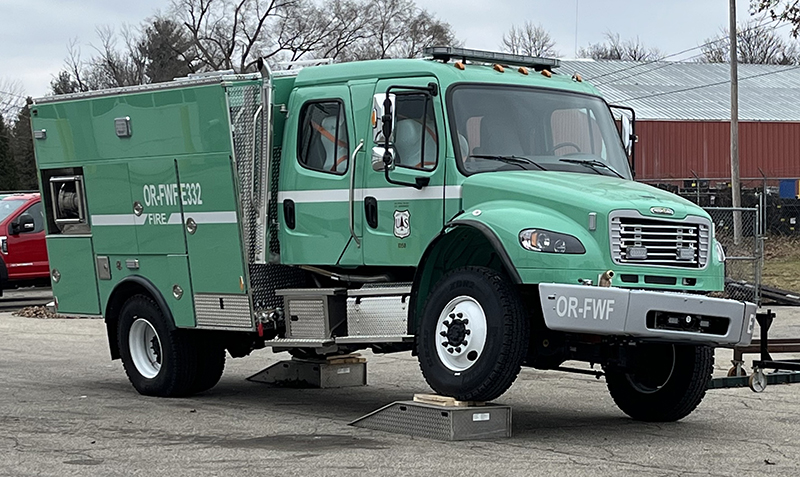
By Bill Adams
The article “Forest Fires, Wildfires, and the Wildland Urban Interface” (Fire Apparatus & Emergency Equipment, November 2023) ended with questioning if wildland urban interface (WUI) fire apparatus have to comply with National Fire Protection Association (NFPA) standards.
That will be addressed by scrutinizing the “Type 3 Brush Fire Response” vehicle recognized by the National Wildfire Control Group (NWCG). Why the Type 3? Because it is becoming popular in the fire service, and it could inadvertently or surreptitiously be used for interior structural attack.
NFPA DEFINITIONS
The soon-to-expire NFPA 1901, Standard for Automotive Fire Apparatus, and NFPA 1906, Standard for Wildland Fire Apparatus, are referenced because some apparatus contracted to be compliant with them may not be delivered for several years. Along with two other NFPA standards addressing ambulances and airport crash trucks, NFPA 1901 and NFPA 1906 have been amalgamated into one document titled NFPA 1900, Standard for Aircraft Rescue and Firefighting Vehicles, Automotive Fire Apparatus, Wildland Fire Apparatus, and Automotive Ambulances. It is applicable to new apparatus contracted on or after January 1, 2024, with a gross vehicle weight rating (GVWR) greater than 10,001 pounds.
NFPA 1900 does not define a WUI pumper. It has 10 classifications of fire apparatus, and WUI pumper isn’t one of them.
For example, NFPA 1900 Chapter 3-Definitions, sentence 3.3.310*-Wildland Fire Apparatus defines wildland fire apparatus as follows: “Fire apparatus primarily used for wildland fire response.” Sentence 3.3.313-Wildland Fire Suppression Apparatus says: “A fire apparatus designed for fighting wildland fires that is equipped with a pump, a water tank, limited hose and equipment, and pump-and-roll capability.”
Significant is NFPA 1900 Annex A, sentence A3.3.310 Wildland Fire Apparatus, which states: “Wildland Fire Apparatus are designed primarily to be used for wildland fires response for both on-road and off-road locations. To a limited degree, these apparatus can be used to protect exposures or fight structure fires from the exterior. These apparatus are not intended to replace or supersede the function of pumpers or initial attack fire apparatus. The terms structural fire apparatus and wildland fire apparatus together make up fire apparatus.” (Underlining is mine for emphasis.)
DEFINING TYPE 3
Type 3 is an undefined, confusing term used by fire apparatus manufacturers (OEMs) and purchasers alike. It is as ambiguous as “Class A Pumper” and “Triple Combination Pumper.” Everyone thinks they know what they mean, but there’s no formal definition for them. Type 3 is similar to trademarked names that have become genericized such as Xerox copy, Kleenex tissue, and Scotch tape.
The NFPA does not recognize Type 3. The federal government does recognize it in a convoluted manner. The NWCG has abbreviated requirements on a one-page chart for seven types of fire engines (apparatus) it recognizes. “Fire Engines” is their description—not mine. None require 100% NFPA compliance. Type 3s are classified to address a “brush fire response,” which could encompass a small grass fire alongside the highway or a raging forest fire. Refer to the previous article or search the Internet for a brush fire definition acceptable to your liking.
NWCG membership includes government representatives from the U.S. Department of Agriculture’s Forest Service (USFS); U.S. Department of the Interior’s Bureau of Indian Affairs, Bureau of Land Management (BLM), Fish and Wildlife Service, and National Park Service (NPS); U.S. Department of Homeland Security’s Federal Emergency Management Agency’s (FEMA) U.S. Fire Administration (USFA); and the U.S. Department of Defense. Other members include the Intertribal Timber Council, National Association of State Foresters, and International Association of Fire Chiefs (IAFC). Amazingly, the NFPA is not included!
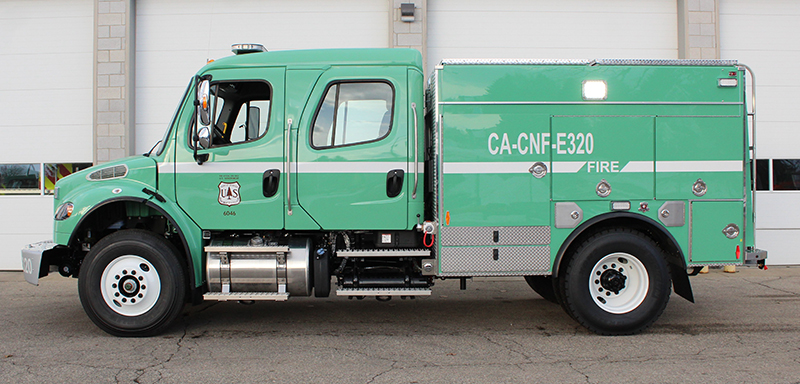
1 Engine 320 is a typical USFS Type 3 apparatus mounted on a 4×4 chassis with a 250-gpm pump and 500-gallon tank—nothing fancy. (Photos 1-5 courtesy of HME-Ahrens Fox.)

2 Engine 320’s rear-mounted pump panel. USFS Type 3s are required to have onboard foam systems. The controls are on the panel’s right side. A booster reel is in the compartment below the hosebed.
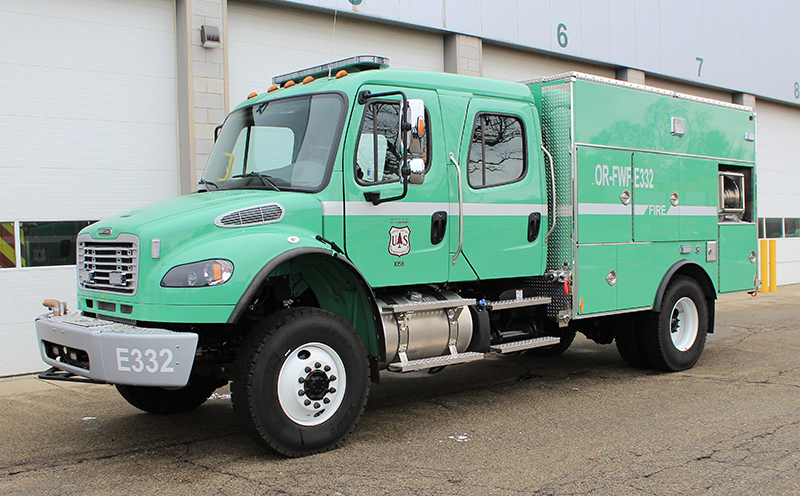
3 Shown for comparison is USFS Engine 332, a Type 4 apparatus. Type 4s have a minimum 750-gallon tank, a smaller pump, and reduced hose capacity. Booster reels are recessed above the low side compartments behind the rear wheels. Although this rig has four doors, only two seats are required by the NWCG.

4 Wildland suppression apparatus have more stringent angles of departure and approach, ground clearance, and stability requirements than structural apparatus. USFS Engine 332 is undergoing a counter twist test.
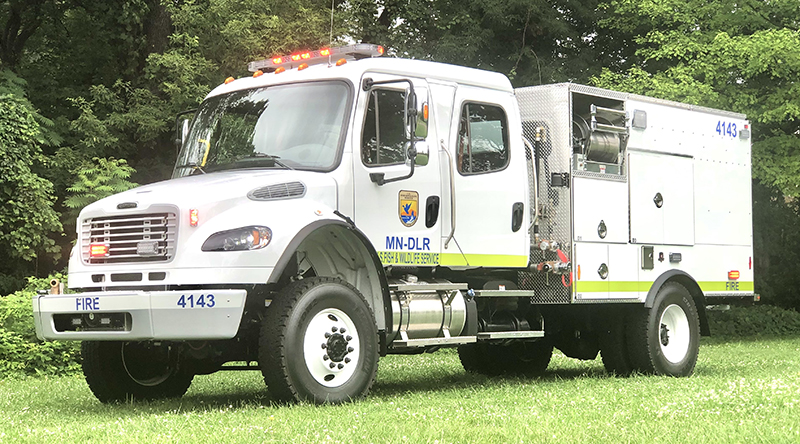
5 This U.S. Fish and Wildlife Service Type 4 rig has recessed booster reels mounted above the compartments immediately behind the cab. It is painted white. Some National Park Service rigs are also.
The NWCG’s Type 3 minimum requirements are a 500-gallon tank; 150-gallon-per-minute (gpm) pump @ 250 pounds per square inch (psi) and 250 gpm @ 150 psi, capable of priming and pumping from a 10-foot lift; 1,000 feet 1½-inch hose and 500 feet of 1-inch hose; pump-and-roll capability; and an onboard foam proportioning system. It must meet federal, state, and agency requirements for motor vehicle safety standards, including all GVWRs. Those are insufficient data to specify a new fire apparatus.
Following NWCG guidelines is the same concept fire departments use when following the NFPA’s minimum fire apparatus standards. Both are foundations to design apparatus specific to their response districts. Type 3s destined for the heavily forested Green Mountains in Vermont might require design features different than those headed toward the flatlands in the nation’s Midwest or the fire-prone foothills and Santa Ana winds in California. The NWCG one-page chart is a far cry from the soon-to-expire NFPA 1901 and 1906 and the future 375-page NFPA 1900.
U.S. FOREST SERVICE
The USFS administers 193 million acres of land. It buys a lot of fire apparatus. Its Type 3 specifications are referenced for convenience because they are the easiest to find in the labyrinth of government Web sites. Somewhat detailed Type 3 body specifications as well as both 2×4 and 4×4 cabs and chassis specifications are found at https://www.fs.usda.gov/managing-land/fire/engines.
The USFS specification exceeds NWCG requirements. USFS Type 3 Models 326 and 346 Body Specifications sentence 1.1.1 states: “The apparatus described in this specification shall be compliant with the requirements of NFPA 1906, latest edition, except where noted.” Unfortunately, “except where noted” is difficult to find.
Noteworthy is Models 326 and 346 have specific criteria for axle loadings. The USFS specification’s sentence 1.2.1 reads: “The in-service weight shall not exceed 90% of the front axle gross axle weight rating (GAWR) and 20,000 pounds on the rear axle when fully loaded with water, foam, and fuel with 270 pounds per seat and 2,300 pounds of equipment evenly distributed in the storage compartments.” I interpret this to mean that the “real in-service maximum weight” of a Type 3 can be established by taking 90% of whatever front GAWR is chosen and adding 20,000 pounds.
It appears that the USFS axle loading requirements are more specific than NFPA 1900 Section 7.14.4-Weight Distribution sentence 7.14.4.1*, which reads: “When the fire apparatus is loaded to its estimated in-service weight, the front-to-rear weight distribution shall be within the limits set by the chassis manufacturer.” Sentence 7.14.4.2 states: “The front axle loads shall not be less than the minimum axle loads specified by the chassis manufacturer, under full load and all other loading conditions.” Good luck in finding those exact figures—in writing—from the chassis manufacturers.
NFPA 1900 Appendix A, sentence A.4.13.2.1 states: “The distribution of the weight between the front wheels and the rear wheels should be a major consideration, because improper design will seriously affect the handling characteristics of the fire apparatus. Too little weight on the front wheels can cause a front-end skid and, on bumpy roads, can cause the front of the fire apparatus to veer from side to side. At the very least, it will be difficult to keep the fire apparatus under control. Too much weight on the front wheels reduces the traction of the rear wheels and can result in a rear-end skid or difficulty in traveling over unpaved roads or in mud.”
My presumption is that the USFS is aware of the terrain including road characteristics and weight restrictions found in its varied response areas and has established definitive specifications for axle loadings. The USFS allows deviations from its specifications when requested by the regional office where the rig is destined, and it has an established format to do so.
PARKS, FISH, and WILDLIFE
The NPS is another NWCG organization that purchases fire apparatus under the guidelines of the NWCG. Its rigs are painted white. NPS apparatus are purchased through the BLM. The NPS covers less than half the area the USFS does. Its fire protection assets can be accessed at https://www.nps.gov/orgs/1231/responding-to-fires.htm.
The U.S. Fish and Wildlife Service Web site calls itself “a smaller wildland fire agency” and states: “Working in fire for the U.S. Fish and Wildlife Service is unlike any other wildland fire position you’ve ever had.” It doesn’t purchase many rigs.
DEPARTMENT OF DEFENSE
Another NWCG member, the Department of Defense, has various military branches that purchase apparatus including Type 3s. In reviewing two branches’ Type 3 purchasing specifications, it appears they also follow the NWCG guidelines, require NFPA compliance with either NFPA 1906 or NFPA 1901, and have extremely detailed technical specifications.
Significant in several Type 3 military specifications were line items allowing minimum and maximum dimensions for the wheelbase, bumper extension length, body width, overall height, overall length, and rear step length. That is a nonrestrictive requirement that should encourage competitive bidding. Acceptable body materials varied, including galvanneal steel, stainless steel, and aluminum.
One specification allowed both the angles of approach and departure to be from 42 to 45 degrees. Another allowed an angle of approach from 30 to 32 degrees and an angle of departure from 25 to 28 degrees. As a comparison, NFPA 1900 requires a minimum 8-degree angle of approach and departure for structural apparatus and a minimum 20-degree angle of approach and departure for wildland apparatus. Yet another specified a Type 3 on a 6×6 chassis with 16,000-pound front axle and 40,000-pound rear axle ratings. Based on the military’s past experiences and topography, these apparatus are no doubt location-specific—probably intended for terrain similar to rifle and artillery ranges in the boondocks and not typical flatland stateside housing and barracks areas.
RAMP BREAKOVER ANGLE
NFPA 1900 Chapter 3-Definitions, sentence 3.3.236 Ramp Breakover Angle defines breakover angle as: “The angle measured between two lines tangent to the front and rear tire static loaded radius and intersecting at a point on the underside of a vehicle that defines the largest ramp over which the vehicle can roll.” It’s also defined in NFPA 1901 and NFPA 1906. The USFS Type 3 Models 326 and 346 Body Specification sentence 1.41-Ramp Breakover Angle says: “The ramp breakover angle shall be maintained with the installation of the fire package.” Does the Forest Service know something the NFPA doesn’t?
Why is this important? Owners of pumpers with deep hose well compartments recessed in the running boards will want to know after they bottom out and crush them. Ditto goes for owners of big heavy rescues with “underbelly” compartments that are ripped off when going over a curb. Purchasers of Type 3 fire apparatus designed for off-road applications should investigate before writing specifications.
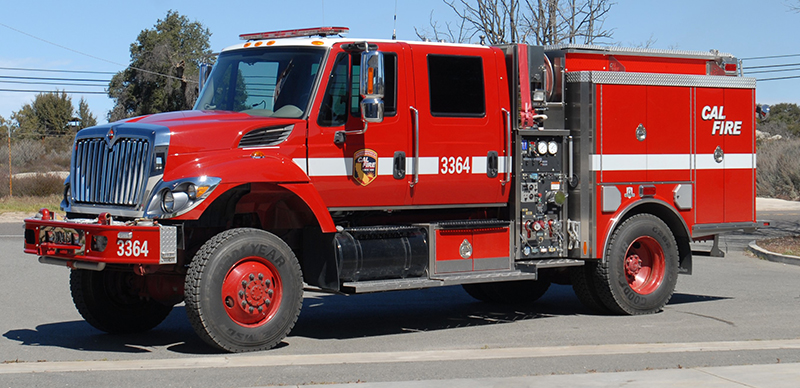
6 Engine 3364 is a typical CAL FIRE 500/500 Model 34 Type 3 apparatus, painted red. It has a 2-inch discharge next to a dead crosslay and a booster reel over the pump house. It sports a leader line wye on one of its lower 2½-inch discharges. (Photos 6-9 courtesy of Tom Shand.)
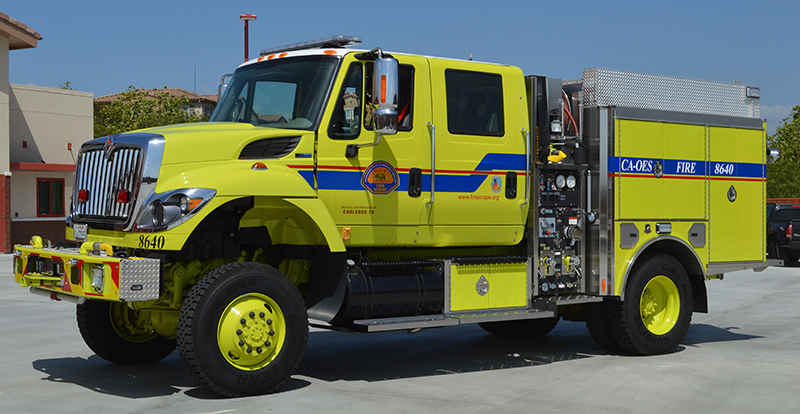
7 Engine 8640 is a CAL-OES Type 3 rig. CAL-OES assigns rigs under contract to various municipalities. The lettering on the driver’s door says “Mutual aid provided by CARLSBAD FD”—obviously where the rig is quartered. This one has a compartment above the right high side compartments; something the CAL FIRE rig did not.
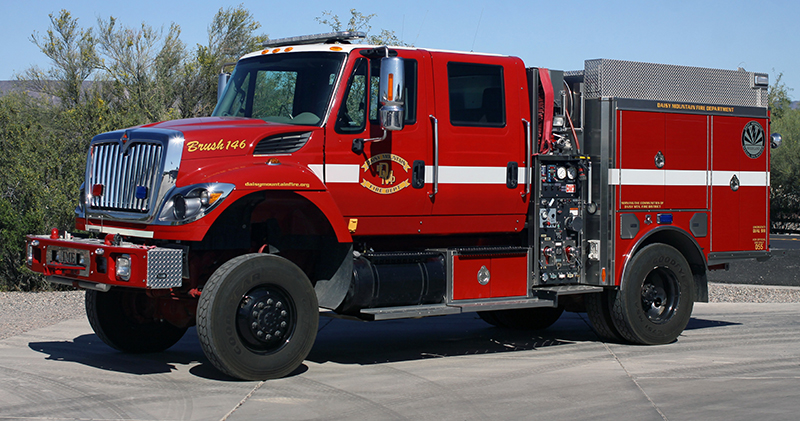
8 Daisy Mountain (AZ) Fire & Medical’s Brush 146 is a 500/500 Type 3 that seems to follow one of the CAL specs. The compartment above the driver’s high side compartments is treadplate like the CAL-OES rig. The ones on the Valencia County (CA) Fire Department rig [Photo 9] and USFS Engine 320 are painted.
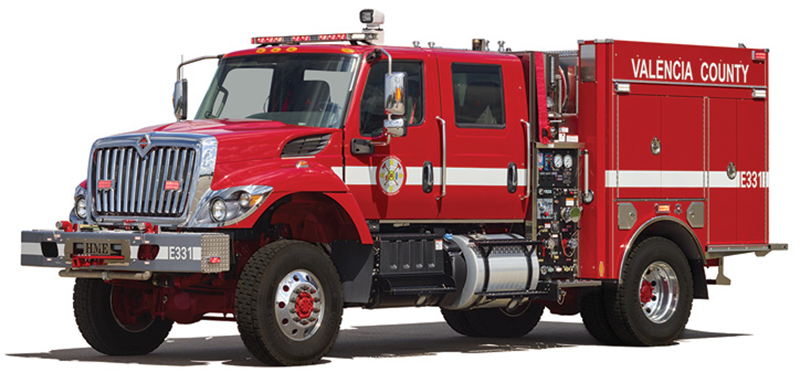
9 Valencia County operates this Model 34F 500/500 Type 3. Its 70-gallon painted fuel tank is located under the crew cab door vs. unpainted fuel tanks under a USFS Type 3 driver’s door. Note the differences in the bumpers’ lights, discharges, and features between municipal departments and USFS apparatus.
There are numerous explanations and definitions with photographs and diagrams of ramp breakover angles on multiple Web sites frequented by off-road and four-wheeler enthusiasts. They are too numerous to list. My summation of a few is: Approach, departure, and breakover angles are important in off-road driving, showing how steep an obstacle can be driven up, over, and down without bottoming out. Can the vehicle get over obstacles such as rocks, fallen trees, berms, and debris? Breakover angles are contingent on wheelbase, ground clearance, and how close axles are located to the front and rear of the vehicle. If a breakover angle is important enough to be defined by the NFPA and even the USFS, it should be further explained in simple terms to purchasers. How do you specify an acceptable angle, and should you?
SEATING
NFPA 1900 does not require a minimum number of seats on wildland fire suppression apparatus. The NWCG requires a minimum of three personnel on a Type 3 rig. USFS Type 3 specifications require a minimum of four seats. Three military specifications examined for Type 3s also require four. One domestic OEM recently advertised a Type 3 rig for the BLM that had five seats. It also had a 40,000-pound GVWR and an aluminum body. (The NWCG has no maximum GVWR for Type 3s.)
INTERVIEW WITH ED BORING
Apparatus manufacturer HME-Ahrens Fox has extensive experience building various types of wildland apparatus for entities throughout the Western United States. Fleet Sales Manager Ed Boring agreed to an interview to help potential purchasers understand the intricacies of purchasing a Type 3 apparatus.
Is the USFS Type 3 Fire Engine-Model 326/324 apparatus specification, issue date: February 2016, only used by the USFS?
“Yes, however some state and local fire departments occasionally will.”
About how many Type 3s does the USFS purchase in a year?
“Roughly 25 to 30.”
The USFS Type 3 specification says the apparatus is to meet NFPA 1906 unless otherwise noted. Does the spec say when noncompliance is okay?
“It’s typically not noted. It is mutually understood.”
The USFS Type 3 specification says compartments shall be attached to substructures. Does “attached” include strip, continuous, and plug welding?
“That is a difficult one to explain. It is a general performance-based description.”
Is adhesive bonding an acceptable method of attachment?
“No, that would not be acceptable.”
Will the USFS consider an optional bid for the entire rig?
“In my experience, I would say no.”
Will the USFS consider exceptions and alternate bids for component parts?
“Occasionally. They will consider alternate components that are of equal quality and performance.”
Has the USFS ever specified a Type 3 without warning devices, stating the rig will not be used to call for or block the right-of-way on a public highway?
“Not to my knowledge.”
Does the USFS specify many Type 3 rigs on two-wheel-drive chassis?
“Yes.”
Has the USFS ever specified an alternative chassis manufacturer for Type 3s?
“Yes.”
Does the USFS Type 3 specification only denote steel and not specifically stainless steel for substructures and compartments?
“Correct, however, HME-Ahrens Fox only fabricates with stainless steel, which is acceptable.”
Do municipal fire departments use the NWCG chart as a template when designing a Type 3 apparatus?
“I would say YES for departments that contract or supply resources (mutual aid) to state and national fire incidents regularly and NO to those that do not.”
Do municipal fire departments specify Type 3 rigs to be NFPA 1906 or NFPA 1901 compliant?
“Typically, yes.”
The new NFPA 1900 has requirements for Pumper Apparatus (8.5), Initial Attack Apparatus (8.6), and Wildland Apparatus (8.12). Should fire departments specify one to follow when purchasing a Type 3?
“In my opinion, definitely yes.”
Are municipal fire departments specifying Type 3s with pump capacities larger than the NWCG’s minimum?
“Yes, many departments prefer a rated fire pump, so 1,000 gpm seem to provide the balance they like.”
Are many municipal fire departments specifying Type 3s with side-mounted pump operator panels?
“Municipal departments use side pump controls more often than rear-mount controls mainly because of the midship-mounted larger-volume-rated fire pumps. Rear controls are more typical for PTO-drive fire pumps of 350 gpm and less.”
Do CAL FIRE and CAL-OES Type 3s have to be fully compliant with an NFPA standard?
“Yes, 1906 previously.”
What are the differences between CAL-FIRE and CAL-OES Type 3 apparatus?
“They are identical except for color, mobile radios, and slightly different loose equipment caches.”
When California municipal departments purchase their own Type 3 apparatus, do they specify that they meet CAL FIRE or CAL-OES specs?
“Typically, yes and with NFPA 1906 compliance.”
Do fire departments outside of California have their own versions of a Type 3 apparatus?
“I would say they often use the CAL FIRE specification, but the farther east you go the more they fade away from the Type 3 configuration and the more they blend into the typical East Coast brush truck.”
Do state fire agencies outside of California have their own versions of a Type 3 apparatus?
“I would say that the western states mimic CAL FIRE, USFS, and BLM specs. As you head east, my previous comment applies.”
Are there many municipal departments or state fire agencies that purchase Type 3s identical to just the USFS Type 3, Model 326/346 specifications?
“We have sold a few. I think generally municipal departments desire a little bigger fire pump.”
In OEM advertisements, both Type 3 and Type III are seen. Is there any difference between 3 and III?
“No. It is manufacturers having two ways to express the same thing.”
HME-Ahrens Fox has stock Type 3s advertised as Model 34F Type III. Do they meet both CAL FIRE and CAL-OES Type 3 specs?
“Yes, they can and do.”
Are all HME Model 34F Type III bodies stainless steel?
“Yes.”
Do you have any words of wisdom for fire departments that want to specify a Type 3 apparatus?
“I think, like with all apparatus, it’s important to distinguish between wants and needs as well as the primary mission vs. tertiary needs. This allows you to customize the unit to perform best for its intended use. Articulate those needs to the manufacturer so it can determine weight and balance, loose equipment storage needs, as well as suppression capabilities. By having a well-defined needs document, you can assure the performance, safety, and reliability of the rig you buy.”
INTERIOR STRUCTURAL ATTACK?
The NWCG’s Type 3 has the bare minimum requirements of a brush fire response vehicle acceptable to the varied organizations it represents. Those organizations, such as the USFS, then develop their own versions specific to their hazards and response areas. State fire agencies like CAL FIRE and CAL-OES do the same. Local fire departments do likewise, with most specifying a larger-volume pump and minor body modifications.
At this point, many firefighters might step back and say, “Hey—we can use on this type or that type of fire.” Understaffed as well as financially strapped fire departments might look at a Type 3 with desirable local upgrades as a one-vehicle cure-all. That might be a mistake.
I do not believe the OEMs are purposely being deceptive when marketing their version of a Type 3 apparatus. That’s marketing—live with it. However, indirectly suggesting that a rig with physical capabilities much less than those of a full-size pumper can do the same job is debatable. It is as controversial as saying an initial attack apparatus (mini pumper) with a 19,000-pound GVWR can accomplish the exact missions as a full-size pumper with a 45,000-pound GVWR. Remember “two-in and two-out.”
LIABILITY?
The fictitious ABC National Forest has USFS Type 3, 4, and 6 apparatus to meet its specific terrain requirements. At a major incident, the ABC’s fire control requested mutual-aid brush trucks from local fire departments. The Town of XYZ’s volunteer fire company recently purchased what its supplier advertised as a Type 3 rig. However, it was built to NFPA 1906 requirements, not the USFS specs for a Type 3. NFPA 1906 requirements for rollover stability and angles of approach and departure were less than the USFS requirements. It responded and, when on location, the rig tipped over and rolled down a hill.
The City of XZY also responded with its mini pumper, an NFPA 1901-compliant initial attack apparatus the city uses as a brush truck. NFPA 1901 requirements for rollover stability and angles of approach and departure were less than even the NFPA 1906 requirements. After arriving on scene, it also tipped over and rolled down the same hill.
Fire departments should be cognizant of the performance expectations and capabilities of mutual-aid partners’ apparatus, especially when interacting with agencies like the military, forest service, national parks, and the fish and wildlife people. Regardless of what a vendor tells you an apparatus can do, you probably shouldn’t use it in a manner exceeding the limitations (i.e., NFPA standards) set forth in the legal contract that was signed when you purchased it. Don’t unintentionally put firefighters in harm’s way. Good luck.
BILL ADAMS is a member of the Fire Apparatus & Emergency Equipment Editorial Advisory Board, a former fire apparatus salesman, and a past chief of the East Rochester (NY) Fire Department. He has 50 years of experience in the volunteer fire service.

